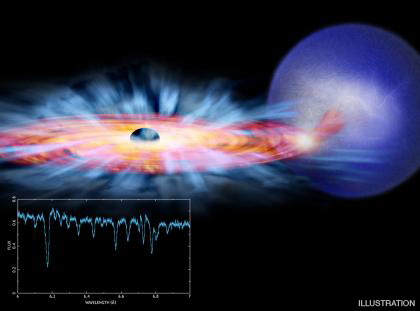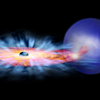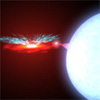NASA's Chandra Answers Black Hole Paradox

Credit: Illustration: NASA/CXC/M.Weiss; X-ray Spectrum: NASA/CXC/U.Michigan/J.Miller et al.
The X-ray spectrum (see inset) of a binary star system consisting of a black hole and a normal star indicates that turbulent winds of multimillion degree gas are swirling around the black hole. As the illustration shows, much of the hot gas is spiraling inward toward the black hole, but about 30% is blowing away.
The temperature and intensity of the winds imply that powerful magnetic fields must be present. These magnetic fields, likely carried by the gas flowing from the companion star, create magnetic turbulence that generates friction in the gaseous disk and drive winds from the disk that carry momentum outward as the gas falls inward. Magnetic friction also heats the gas in the inner part of the disk to X-ray emitting temperatures.
The analysis of the disk wind of GRO J1655-40, or J1655 for short, confirmed what astronomers had long suspected, namely that magnetic friction is central to understanding how black holes accrete matter rapidly. Without a process to take away some of the angular momentum of the gas, it could remain in orbit around a black hole for a very long time.
J1655 is a binary system that harbors a black hole with a mass seven times that of the sun, which is pulling matter from a normal star about twice as massive as the sun. The Chandra observation revealed a bright X-ray source whose spectrum showed dips produced by absorption from a wide variety of atoms ranging from oxygen to nickel. A detailed study of these absorption features shows that the atoms are highly ionized and are moving away from the black hole in a high-speed wind.
Understanding the importance of magnetic forces in the disk of gas around J1655 could have far-reaching implications, from the supermassive black holes associated with powerful quasars, to planet-forming disks around young sun-like stars.
|
||||||||||||||||||||||
The graphic contains an illustration in the main panel and a smaller inset Chandra X-ray Observatory spectrum of a binary star system called GRO J1655-40. GRO J1655 consists of two stars orbiting each other. One of the stars is a black hole (at left) and the other is a normal star (at right), with a thin link of material between the two of them as the black hole siphons off matter from the star. In the illustration, there is a bright blue light coming off of the area of the black hole and its disk. The graph, or spectrum, on the lower left side represents the intensity of the X-rays emitted by the binary star system over time with little fluctuations. It indicates that turbulent winds of multimillion degree gas are swirling around the black hole. The colors in the image are predominantly blue and purple, with some red and oranges in the central area of the black hole's disk. As the illustration shows with the bright blue light escaping the back hole, much of the hot gas is spiraling inward toward the black hole, but about 30% is blowing away.





